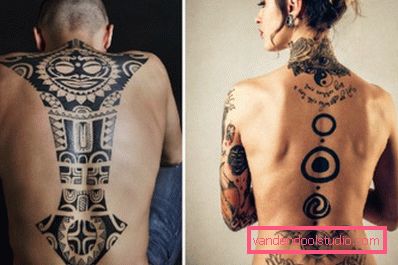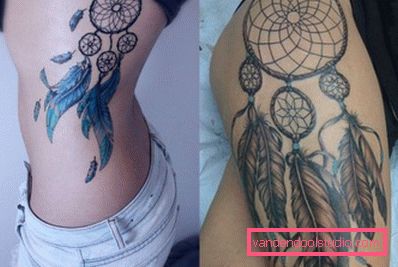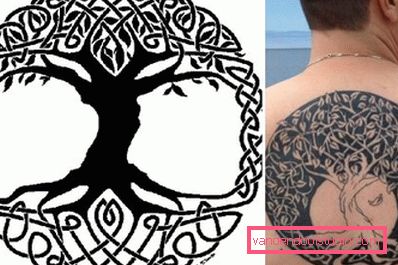Ethnic tattoo - the ancient art of tattooing in the modern

Ethnic Tattoo is a trend that gained popularity not so long ago. Ethnic tattoos take their origins from ancient times. They were characteristic of the Byzantine peoples, Scythian tribes, Celts and other cultures. Ethnic style tattoos can cover almost the entire human body, intricate patterns are voluminous and diverse. In the times of antiquity, people applied various ornaments and marks showing the status of a person, his life achievements, or simply decorating the body. Also, ethnic tattoos were a kind of amulets and amulets.
Tattoo artists combine ethnic design sketches with contemporary art. Ethnic tattoos are very noticeable, they are hard to confuse with another direction. The drawing is composed of smooth lines and dots, which are ideally combined with strokes.

Varieties of ethnic tattoos
For many years, several areas of ethnic tattoo have been formed. There is a conditional qualification:
- Scythian tattoos;
- Indian tattoos;
- Celtic;
- Polynesian;
- Japanese tattoos.
This is not a complete list. Every year all new trends and styles are popularized. Let us dwell on the most famous details.

Scythian tattoo style
Pads of this direction are distinguished by their special originality, brightness and expressiveness. Although the overwhelming part of the tattoos was invented by modern masters, it is based on genuine elements of the culture of the Scythian peoples. An example is the body of a warrior leader found at an excavation site in the Altai Mountains. Numerous peculiar drawings were made on it. It turned out that they were made by impaling. The execution of all the elements was done in the animal stylistics, and on the chest there was a place for the image of a griffin lion, personifying greatness and great strength. You can see this in the photo on the Internet.

In the modern Scythian style on the tattoo in the style of ethnics, the main pattern is done in front. Images contain images of animals or mythical creatures. The design of the back of the body should complement the front, but the drawings are not particularly complex.
Indian style
Native American ethnic tattoos are particularly mysterious and mysterious. They are colorfully decorated, they have a deep meaning. The most famous is the dream catcher. This tattoo helps protect against negative energy and get rid of nightmares.

Animals depicted on the human body have their meanings. The bear symbolizes courage and strength, and also indicates the victory of the owner in an unequal battle. The bull says that the owner of this ornament is a desperate and risky person. The wolf conveys such qualities as intuition and perseverance. Portraits of Indian women, which symbolize not only fame and courage, but also beauty and grace, are popular among girls.
Celtic style
Perhaps the most popular trend in ethnic tattoo. It was constantly influenced by other cultures, so it is not individual and homogeneous. Images are characterized by the presence of leaves and other components of various plants. Later drawing began to complement animals. All together it looks quite original and harmonious.

Polynesian style
It gained popularity quite recently - only at the beginning of the 21st century. The origins of the modern ethnical tattoo in this direction come from the tribal ornaments that were used to decorate the bodies of the priests of the tribes. The owner of such ornaments received general honor and respect. Special vegetic spikes or fish bones were used to apply body patterns. The variety and sophistication of the images showed the noble origin of man.

Such elements as spirals on the chin, two large spirals on the cheek were usually applied. There were also curved lines, in the form of rays, diverging from the nose, passing over the eyebrows and descending to the ears.
Japanese style
Sketches of this direction are borrowed from Chinese culture. Conventionally, they are divided into two categories: iredzumi and gaman. The first type is inherent to convicts who were forced to apply subcutaneous drawings. The second was a demonstration of such quality in men as patience.
Special respect in Japanese culture was given to female tattoos. They were performed by rubbing rice powder in cuts on the skin. They appeared only when excited or after water treatments. The images were attended by dragons and samurai, and as the motives were old tales and legends about the sea.

Previously, tattoos in Japan were in privileged persons, and the pattern was passed down from generation to generation. In modern times, the people of Japan do not really like this kind of body art, because criminals often adorn their bodies with tattoos.
For each nation, its meaning is embedded in a certain image. But at the present time, the meaning of the ethnic tattoo is not given special attention. These images do not have age and gender distinctions. Anyone can see a photo with sketches and choose a tattoo for himself, the motif of which will be combined with the ancient symbolism and the modern component.